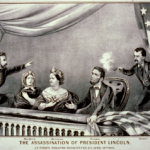Weekly Wrap Volume 34
 Can Color Blind People See More Colors When They Take Hallucinogenic Drugs?
Can Color Blind People See More Colors When They Take Hallucinogenic Drugs?
First a little primer on colour blindness from the good people at ColorBlindAwareness.org: “Most color blind people are able to see things as clearly as other people but they unable to fully ‘see’ red, green or blue light. There are different types of color blindness and there are extremely rare cases where people are unable to see any colour at all.” The ability to see colours is entirely due to certain photoreceptors called “cones” located in your eyeballs. Normal eyes contain three distinct kinds of cones that work together to perceive colours. However, in people with colour vision deficiency (CVD)… (more)
 Abraham Lincoln Established the Secret Service on the Day He was Shot by John Wilkes Booth
Abraham Lincoln Established the Secret Service on the Day He was Shot by John Wilkes Booth
Unfortunately, even had the organization been instituted earlier, it wouldn’t have helped. The Secret Service in the beginning had no part in protecting the President, but rather were tasked with cutting down on the amazing amount of counterfeit money circulated in the United States at the time (hence why until March of 2003 they were a branch of the U.S. Department of the Treasury). It is estimated that about 1/3 of the U.S. currency in circulation was counterfeit when Lincoln signed the piece of legislature that would establish the Secret Service. Lincoln did technically have a permanent assigned guard on the night of his murder, but a more inept guard they could not have found for the President. The man was policeman… (more)
 The Good and the Bad of Vaporizing and Inhaling Alcohol
The Good and the Bad of Vaporizing and Inhaling Alcohol
Vaporizing, and then inhaling alcohol has gained a lot of attention lately. In the 1950s it was introduced as a treatment for excessive fluid in your lungs, called pulmonary edema. It’s now gained popularity as a way to quickly become intoxicated. Proponents of this process-to-become-plastered, tout several benefits compared to drinking it. Many claim you get drunk without any calorie intake. Some state, because you bypass the liver, you can eliminate the alcohol quickly and avoid the dreaded alcohol hangover. Just about every medical professional commenting on this method of intoxication have warned of the very real consequences. All while knowing doctors can use the process to treat some life threatening medical conditions. Before you go to… (more)
 Was the Character of Sherlock Holmes Based on a Real Person?
Was the Character of Sherlock Holmes Based on a Real Person?
In 1887, Doyle published the novel “A Study in Scarlet.” It was the first work to star Sherlock Holmes and Dr. Watson. It was also the first record of a magnifying glass being used as a tool of investigation. “A Study in Scarlet” didn’t attract much attention (and neither did it’s sequel, “The Sign of Four.”) but in the July 1891 issue of “The Strand Magazine”, Doyle published the first short story starring Holmes. That’s when the detective began to take off in popularity. Even early on, readers wanted to know who was the basis for this new type of crime fighter. Doyle couldn’t have just conceived this eccentric, brilliant, logical character out of thin air, right? After more than a century since Sherlock Holmes made his first appearance on paper, evidence points to Holmes being based on primarily two individuals, as well as, perhaps, the author himself. At the young and impressionable age of 18… (more)
The name, “Chicken Pox” is vernacular for the Varicella Zoster Virus. While it has a name that evokes cuteness and is even silly, it is a disease that can, though rarely, claim the life of a child. Prior to the May 1995 introduction of the Varicella vaccine, over four million people would suffer from the Chicken Pox every year- approximately 100 would die. The first documentation of the virus is credited to the Italian, Giovanni Filippo (1510-1580) of Palermo. Of course, then, it wasn’t called Chicken Pox. It was named as the “Varicella Virus”. Chicken Pox is a strictly English language term for this virus. The French call it Varicelle. The Spanish call the virus Varicela. Only the Germans call Chicken Pox by anything even remotely similar. They… (more)
Bonus Quick Facts:
- The first website ever made was created by Tim Berners-Lee and published on August 6, 1991. It served up a page explaining the World Wide Web project and giving information on how users could setup a web server, as well as how to create their own websites and web pages.
- Bubble Wrap was invented by two engineers Al Fielding and Swiss inventor Marc Chavannes in Hawthorne, N.J. in 1957. The two were not, however, trying to make a product to be used as packaging material. Rather, they were trying to create a textured wallpaper. It was three years after the initial creation of Bubble Wrap that Frederick W. Bowers, a marketer at Sealed Air, which makes Bubble Wrap, finally came up with the perfect use for their product. On October the 5, 1959, IBM announced their new 1401 variable word length computer. Bowers got the idea that Bubble Wrap could be used as a good packaging material to protect the computer while it was being shipped. He then pitched the idea to IBM and demonstrated Bubble Wrap’s protective abilities. His demonstration went over well and IBM began purchasing Bubble Wrap to protect their 1401 and other fragile product they sold and shipped.
- The guy who did the voice for Optimus Prime also did the voice for Eeyore, in the Winnie-the-Pooh series, and was the first person to voice Nintendo’s Mario character. The man is Canadian voice actor Peter Cullen. Cullen not only did the voice of Optimus Prime in the original Transformers series, but he also did the voice of Optimus Prime in the 2007 Transformers, 2009 Transformers: Revenge of the Fallen, and the 2011 Transformers: Dark of the Moon. He also did the voice of Optimus Prime in the Transformers: War for Cybertron video game.
- The late Kim Jong-Il was born Yuri Irsenovich Kim. His official biography states that he was born on a sacred mountain (Baekdu Mountain, the legendary birthplace of Korea’s first kingdom) on February 16, 1942, where his father was serving in a secret military base, attempting to overthrow the Japanese. Further, it states that his birth was marked by a double rainbow over the mountain, a new star appearing in the sky, and, before his birth, a swallow foretold his coming. Besides the obvious parts of this that aren’t true, he also was not born on Baekdu Mountain in 1942, but rather was born in Vyatskoye, Khabaroskv in 1941. Vyatskoye is a small hamlet in Russia. Kim’s father, Kim Il-Sung, was actually a commander in the Soviet 88th Brigade there. After WWII, Korea gained its independence from Japan and the family returned to Korea where his father began being groomed to rule by the Soviets, first being installed by Stalin as the head of the Provisional People’s Committee. Shortly thereafter, he was made Prime Minister and eventually became President.
- Despite toilet paper having been around since at least the 6th century AD (initially in China), it wouldn’t be until the late 19th century when toilet paper would be first introduced in America and England and it wasn’t until the 1900s, around the same time the indoor toilet became common, that toilet paper would catch on with the masses.
Other Interesting Stuff:
 The Exploding Anti-Tank Dogs of World War II
The Exploding Anti-Tank Dogs of World War II
These dogs, usually Alsatians, were also called “Hundminen” or “dog mines.” They were trained to carry explosives on their bodies to enemy tanks, where they would then be detonated. No, it did not end very well for the dogs in question. This type of animal weaponry was first used by the Soviets. Following a decision in 1924 to allow dogs to aid the military, a dog training school was set up in Moscow. The military recruited such people as police dog trainers, hunters, circus trainers, and animal scientists. Twelve more schools were set up hot on the heels of the first one and the Soviet dog-training division started out in earnest… (more)
 The Bizarre Tale of Phineas Gage
The Bizarre Tale of Phineas Gage
What was supposed to be just another day on the job for 25-year-old Phineas Gage turned out to be anything but, with events transpiring to make him a legend – in neurology anyway. On that fateful day, Phineas Gage suffered a traumatic brain injury when a very large iron rod went through his head. Despite this, he survived and became one of the first to demonstrate a clear link between brain trauma and personality change. On September 13, 1848, Gage was helping excavate rocks to make way for a railroad track on the Rutland and Burlington Railroad near Cavendish in Vermont. Just prior to the accident, Gage was preparing for an explosion by compacting a bore with explosive… (more)
 The First Known Robot Created in 400 BC
The First Known Robot Created in 400 BC
The first known robot was created around 400-350 BC by the mathematician Archytas and was a steam powered pigeon. Archytas, who coincidentally is known as the “father of mechanical engineering”, constructed his bird out of wood and used steam to power the movements of the robot. This bird was then suspended from a pivot bar and at one point the bird managed to fly as much as 200 meters before it ran out of steam. This is not only the first known robot, but was also one of the first recorded instances of a scientist doing research on how birds fly. Archytas was a very famous philosopher… (more)
 Why Do We Call it Piggyback When We Carry Someone On Our Back?
Why Do We Call it Piggyback When We Carry Someone On Our Back?
Funny how not one of us can likely name a time they have ever seen a pig carry anything on its back; yet we rarely question the term “piggyback”. How could this be? As with many English terms, we have to think back…way back, and usually over time we find a logical progression that allows us to come to a better understanding of a term commonly used that otherwise seems most illogical. To understand the logic behind the term “piggyback”, we must go back as far as the year 1564 or thereabouts. Back in the 16th century, goods were transported in packs that people carried on theirs or animals backs. The term used to describe this was “pick pack” because you would pick up a pack in order to carry it on your back. Seems logical enough so far right? But how does the “omnivorous domesticated hoofed mammal with sparse bristly hair and a flat snout for rooting… (more)
This Week’s Podcast Episodes:
- Podcast Episode #81: Why Geckos’ Feet Can Stick to Just About Anything
- Podcast Episode #82: Why Cats Love Catnip
- Podcast Episode #83: How the Gun in Duck Hunt Worked and Why We Call Bowling Three Consecutive Strikes a Turkey
- Podcast Episode #84: Eric Clapton’s Mother/Sister and Why Rock ‘n’ Roll is Called That
- Podcast Episode #85: The Odd [and Slightly Gross] Thing Worcestershire Sauce is Made Of and Why Cooked Red Meat Turns Brown
- Podcast Episode#86: The Origin of Caesar Salad and Why Salt Enhances Flavor
- Podcast Episode #87: Vikings and Their Helmets and Medieval Bathing Habits (Or Lack Thereof)
| Share the Knowledge! |
|





